1. The impact of antimicrobial use on livestock
The use of antimicrobials in farming has significantly contributed to the growth of intensive animal production, meeting the global demand for animal protein (Figure 1). However, this widespread use has led to the rise of antimicrobial resistance (AMR), posing serious threats to both animal and human health. In fact, antimicrobial use (AMU) in animals accounts for 73% of all antimicrobials used worldwide, contributing to treatment failures and threatening the sustainability of the animal industry (Van Boeckel et al., 2017; Mulchandani et al., 2023).
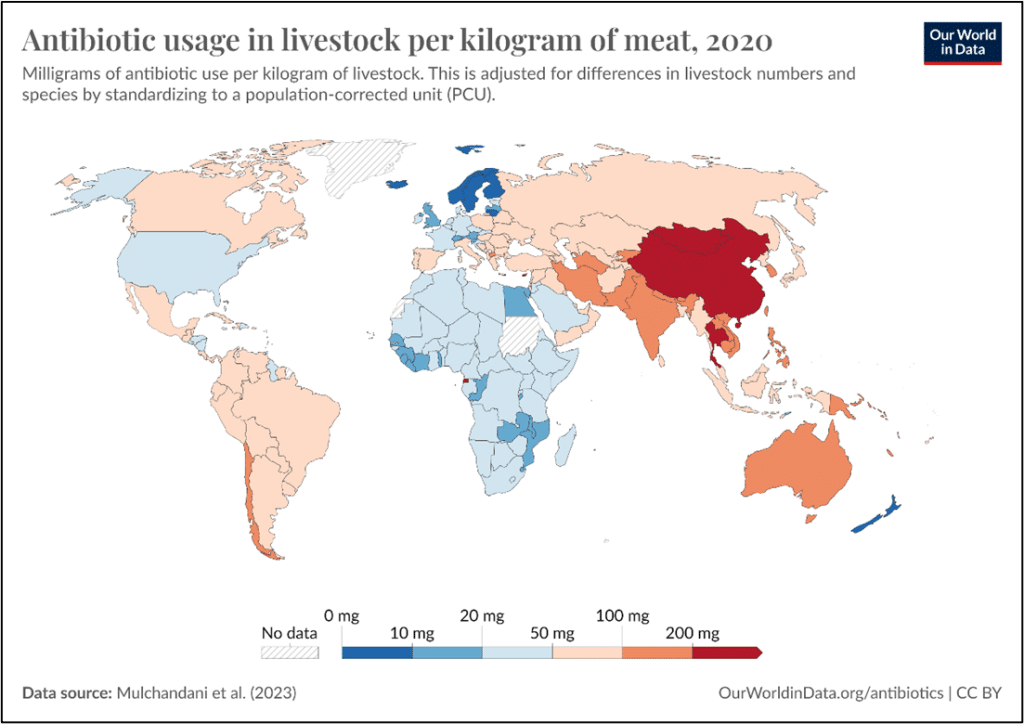
Figure 1: Worldwide antibiotic usage in livestock per kg of meat in 2020 (OurWorldInData.org)
In many countries, multiple antimicrobial compounds are used routinely as growth promoters (AGPs) in animals (increase weight gain and feed efficiency) or as low-cost substitutes for proper hygiene measures. These AGPs include cyclic peptides (e.g., bacitracin), ionophores (e.g., monensin, narasin), streptogramins (e.g., virginiamycin), orthosomycins (e.g., avilamycin), and macrolides (e.g., tylosin, spiramcycin) among others (Dibner, 2005; Van Epps, 2016). Even though these compounds differ in their antimicrobial spectrum and antibacterial mode of action, whether they increase performance through similar or different mechanisms is not clear (Plata et al., 2022) (Figure 2). It is also important to highlight that AGPs are administered at subtherapeutic concentrations (Broom, 2017).
Regarding antibiotics for veterinary use to treat specific infections, tetracyclines are the most commonly used antimicrobials, with their usage predicted to increase by 9% by 2030 (Mulchandani et al., 2023) (Figure 3).

Figure 2: Schematic representation to explain how AGPs could improve productive efficiency in chickens. Subtherapeutic levels of antibiotics modulate microbiota and mitochondrial function, increasing cellular defense mechanisms by inducing an adaptive response. This mechanism can promote growth rate (Adapted from Fernández et al., 2024, images created in https://BioRender.com)
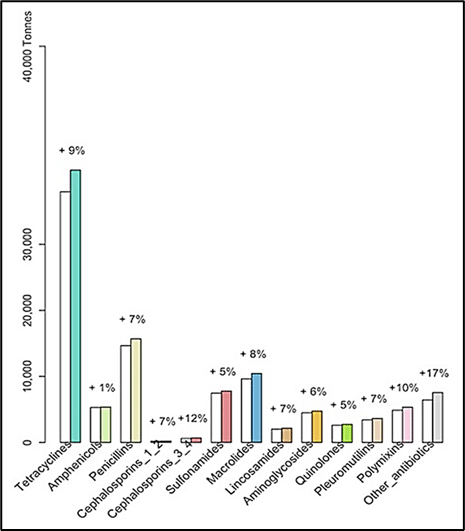

Figure 3: Veterinary antimicrobial consumption in 2020 (white bars) and their projected consumption for 2030 (colored bars) by antimicrobial class (left), and continent (right) (Mulchandani et al., 2023).
In The United States, consumer preferences have driven reductions in antimicrobial use, though the impact on livestock rearing practices is still appearing. In contrast, the European Union’s complete ban on antimicrobial growth promoters (AGP) in 2006 (Regulation 1831/2003/EC) led to increased gut health issues, particularly in broilers, highlighting the interest in intestinal health (Fernández et al., 2024; Zhao et al., 2024).”
In the animal nutrition market, new strategies have emerged to support animal protein production while reducing the use of antibiotics. Nowadays, the focus is to understand the fundamental interactions between the host mucosa, intestinal content, and the microbiota. All these points are crucial for the immunological response, digestion, absorption of nutrients and animal performance.
2. The physiology and immunology of the intestine:
Maintaining intestinal health is essential for the digestion and absorption of nutrients, which directly impacts performance. High-performing poultry lines often face intestinal health challenges due to their substantial feed intake, which strains their digestive systems. Understanding the gastrointestinal tract’s functions—such as digestion, absorption, and its role as a defensive barrier—is crucial for achieving optimal productivity (Ducatelle et al., 2023; Bailey, 2019; Ortiz, 2014).
2.1 Physiology
The modern broiler is renowned for its efficient feed conversion and rapid growth, needing a substantial feed intake. This high intake has significant pressure on the gastrointestinal tract, particularly on the absorptive epithelial cells of the small intestine (Svihus, 2014).
Starting with the oral cavity, birds are designed to pass feed particles from the beak into the pharynx and down the esophagus (mucus production). Once swallowed, the feed is temporarily stored in the crop, where it is moisturized, acidified, and slightly fermented by Lactobacilli (Classen et al., 2016).
The feed then moves into the proventriculus and gizzard. In the proventriculus, the feed undergoes further acidification and initial enzymatic breakdown of proteins, while in the gizzard, the feed particles are reduced in size (mechanical breakdown). The presence of insoluble fiber in the feed enhances gizzard development and function (Svihus, 2011; Sacranie et al., 2012).
Then the feed reaches the duodenum, where it mixes with bile and pancreatic enzymes, preparing the nutrients for absorption. The ileum, located between Meckel’s diverticulum and the caeca, has smaller villi (villus height: duodenum > jejunum > ileum) (SFR, 2024).
Finally, content from the ileum, colon, and cloaca is intermittently transported into the caeca by peristaltic and anti-peristaltic movements. The fiber content of the feed influences cecal development and motility (Svihus et al., 2013) (Figure 4).
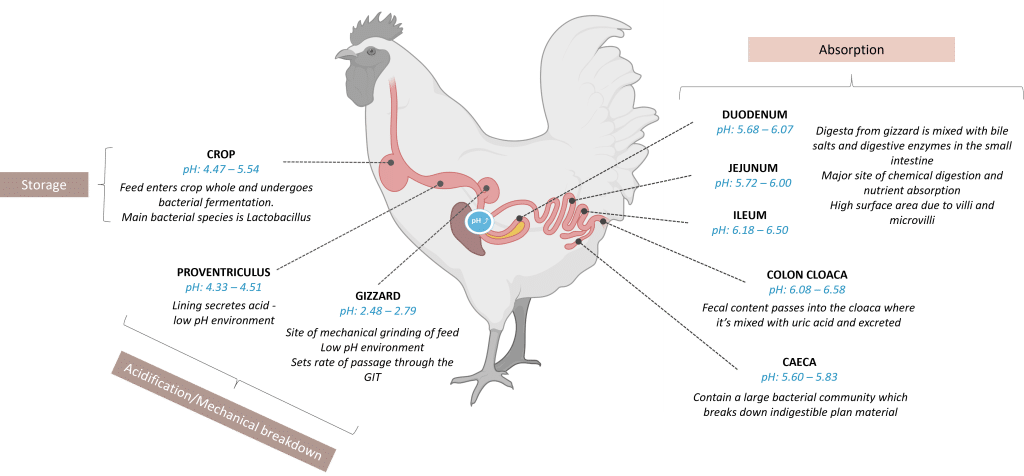
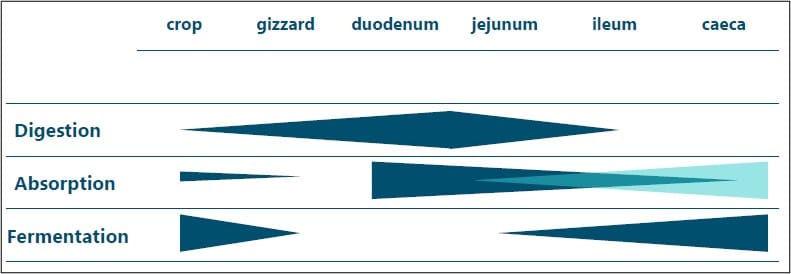
Figure 4: Physiology of the gastrointestinal (GI) tract and its function per segment (Bailey, 2019; SFR, 2024; images created in https://BioRender.com)
2.2 Avian immunology
In birds, there are 2 complementing units within the immune system – innate and adaptive – that work together to recognize and protect against disease-causing agents, including pathogenic bacteria and viruses (Pavlidis, 2019).
Innate immune mechanisms are the bird’s first line of defense, and they are particularly well developed in the small intestine, providing protection against pathogens and bacteria that come into close contact with epithelial cells. This innate immunity contributes to the remarkably low density of microbiota in the duodenum and jejunum. Key components of these mechanisms include a protective mucus layer, IgA, host defense peptides such as β-defensins and lysozyme, all of which defend against invading microorganisms (Yacoub et al., 2015; Veldhuizen et al., 2013) (Figure 5).
In contrast, adaptive immunity takes a more targeted approach against pathogenic microorganisms. Unlike innate immunity, active immunity involves a slower series of reactions primarily, mediated by B and T lymphocytes.
The end products of an adaptive immune response are memory B and T cells, which provide long-term specific protection against subsequent infections with pathogens carrying the same antigens (Kogut et al., 2020).
The rich and complex microbiota in the lumen of the caeca and its mucus layer play a crucial role in the development of intestinal adaptive immunity.
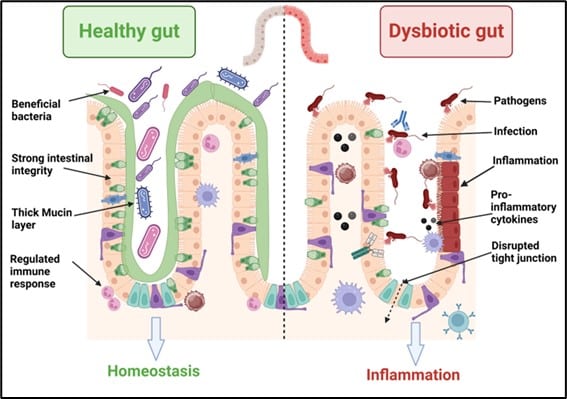
Figure 5: Immune system response face to a normal and an inflamed epithelium (Eveaert, 2025 and based on Hou et al., 2022)
3. The gut microbiota
The gastrointestinal (GI) tract of broiler is home to a diverse microbiota, with an estimated 600-800 species of bacteria. The abundance and diversity of these bacteria varies along the GI tract, and regions with harsher conditions and more rapid transit of intestinal contents host fewer bacteria (Bailey, 2019).
The small intestine’s bacterial population is predominantly Lactobacilli, though Enterococci, E. coli, Eubacteria, Clostridia, Propionibacterium, and Fusobacteria can also be found. Although bacteria are present in the gut of developing embryos, the mature gut microbiota primarily begins at hatching, when chicks are exposed to bacteria from the environment and feed (Ducatelle et al., 2023)
Within 24 hours post-hatch, the crop is rapidly colonized by Lactobacilli, which ferments carbohydrates in the feed and produces lactic acid, lowering the pH of the crop environment. The proventriculus, with its highly acidic conditions, is unsuitable for most bacteria, while the gizzard, also acidic, contains Lactobacilli mainly originating from the crop. 7-day old chicks have an abundance of Firmicutes and Clostridiaceae in ileum (Bailey, 2024; SFR, 2024).
The bacteria population is established at two weeks of age, and in chickens, Bacteroidetes and Firmicutes are the most predominant representatives in the gut. The caeca, providing a more stable environment, allow the colonization of slower-growing fermentative bacteria. There is a higher complexity in microbial composition in caeca and in older birds (Bailey, 2019; SFR, 2024) (Figure 6).
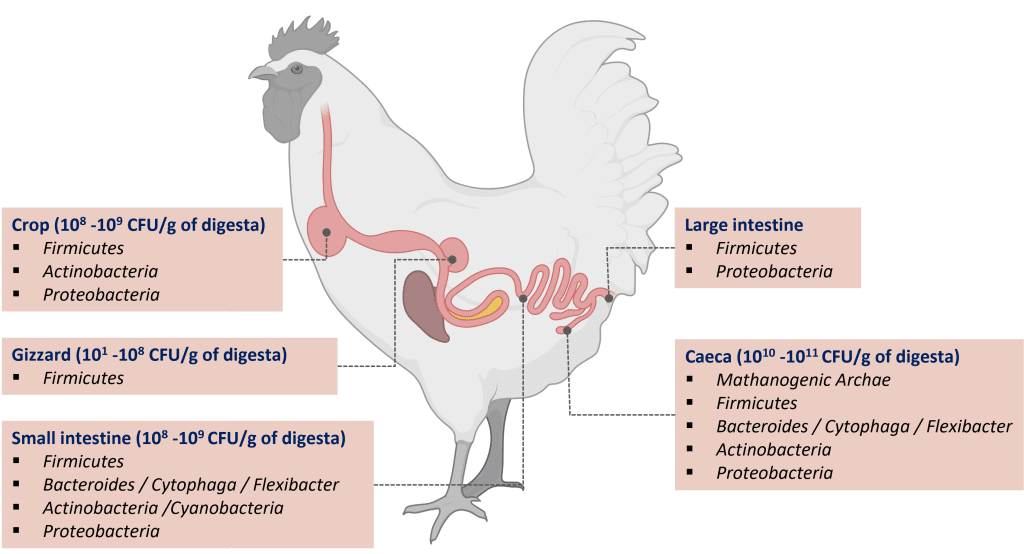
Figure 6: Microbiota in chickens, summarized from Shang et al., (2018). Figure adapted from Delatorre et al., (2024), images created in https://BioRender.com.
4. Gut health balance
The permeability of the intestine is controlled by gut microbiota, digestive secretions, physical and chemical barriers (Delatorre et al., 2024). A disturbance in the gut microbiota can lead to an imbalanced host-microbe relationship, known as “dysbiosis.” Imbalance in the gut leads to localized inflammation, infection, or even intoxication, also causing an incomplete digestion and absorption of nutrients – there are more nutrients being available to the small intestinal bacteria, leading to an overgrowth of the bacterial population – impacting the health and performance of the birds (Delatorre et al., 2024; Bailey, 2019)
Gut balance can be affected by factors such as management, feed quality, the environment, among them:
- Poor gut development
- Feed changes
- Feed quality and raw materials (antinutritional factors in feed, heavy metals, toxic substances)
- Mycotoxins
- Biosecurity
- Environment (Temperature, humidity, and ventilation)
- Infections with viruses, bacteria, or parasites
- Water quality
- Antibiotics

Figure 7: Factors affecting the gut microbiota composition according to Carrasco et al., (2019). Figure adapted from Kers et al., (2018), image created in https://BioRender.com.
Nutrition has been found to be the most influential factor on the composition of the gut microbiota (Delatorre et al., 2024).
5. Nutrition is a non-infectious factor.
In poultry gut health research, the current focus is using nutrition to influence the gut microbiome to produce beneficial ‘interkingdom signals (i.e., indirect interaction through signals that are metabolites produced by the bacteria and sensed by the host). Different nutritional tools are already available to enhance the production of beneficial microbial in the intestine of poultry (Onrust et al., 2015). Among some of the strategies when formulating, there are a few to consider avoiding a negative impact on intestinal health (Table 1).
Table 1: Impacts of nutrition in intestinal health (SFR, 2024)
| Factors related to poultry nutrition | Impacts |
|---|---|
| Overuse of Wheat, barley, rye, oats | Soluble non-starch polysaccharides (NSPs) can increase viscosity à increasing microbial growth. Use of NSP enzymes to reduce the viscosity |
| Bacteria overgrowth | Protein fermentation à metabolites from this fermentation can damage the intestines |
| Bacteria can inactivate bile salts | Bile salts are needed for emulsification à microflora deconjugates bile salts à it decreases fat digestibility |
| Excess of undigested crude protein + high levels of soluble NSPs | Fermented by intestinal bacteria à volatile fatty acids (VFA) à gas production in the small intestines à ballooning |
| Water balance | Osmotic pressure is high in poultry. If there is an intestinal damage -> reduction of absorption of solubilized compounds à higher osmotic pressure inside gut -> Increased water secretion to the intestinal lumen -> Wet litter |
| Coarse particles | It stimulates gizzard development. Longer retention time of feed in gizzard |
Even though there are different strategies, the main one is preventing the multifactorial conditions associated with the gut microbiota imbalance. Numerous studies have shown that alternative products can help to improve gut microbial balance and intestinal integrity such as prebiotics, probiotics, organic acids, phytochemicals, symbiotic among others (Table 2).
Table 2: Some feed additives (Biron et al., 2022; Gadde et al., 2016)
| Feed additives | Definition | Positive impact | Weakness |
|---|---|---|---|
| Phytochemicals | They are natural bioactive compounds that are derived from plants and incorporated into animal feed to enhance productivity |
Improve growth performance
Maintain mucosal integrity Enhanced feed digestion Promote beneficial bacterial strains Inhibit pathogens adhesion Increase immunity in the gut |
Large dose may be needed. Toxicity or other adverse effects |
| Organic acids | Dietary organic acids can be described as either simple monocarboxylic acids (e.g., formic, acetic, propionic, and butyric acids) or carboxylic acids bearing hydroxyl group (e.g., lactic, malic, tartaric and citric acids). |
Improve growth performance
Maintain mucosal integrity Enhanced feed digestion Promote beneficial bacterial strains Inhibit pathogens adhesion Increase immunity in the gut |
Higher dosages may damage the esophagus and stomach. It depends on dose and time, diet, age, environment |
| Probiotics | They are mono or mixed cultures of live organisms which when administered in adequate amounts confer a health benefit to the host |
Improve growth performance
Maintain mucosal integrity Enhanced feed digestion Promote beneficial bacterial strains Inhibit pathogens adhesion Increase immunity in the gut |
Uncertainty about the quality Inactivation during feed preparation, transport, and storage |
| Symbiotic | These additives integrate probiotics and prebiotics to promote a synergistic effect |
Improve growth performance
Maintain mucosal integrity Enhanced feed digestion Promote beneficial bacterial strains Inhibit pathogens adhesion Increase immunity in the gut |
Research studies should be conducted to confirm that these combinations produce a synergistic effect beyond what either component can achieve alone |
| Prebiotics | Non-viable feed components that confer a health benefit on the host associated with modulation of the microbiota |
Improve growth performance
Maintain mucosal integrity Enhanced feed digestion Promote beneficial bacterial strains Inhibit pathogens adhesion Increase immunity in the gut |
Because of the fermentation in the intestines, feeding a higher number of prebiotics might induce bloating, diarrhea, or other effects |
6. CalseaGrow a combination of marine calcified alga and plant extract:
As seen in Part 3, microbial population only starts to stabilize at 2 weeks of age. It becomes then crucial to support chick gut health to allow an efficient microbial population development from post-hatch until end of the cycle. In addition, the fight against antimicrobial resistance is a major public health challenge, and action plans unanimously focus on promoting the prudent use of antibiotics. Several alternatives have been proposed and evaluated in poultry production such as prebiotics.
Phosphea proposes a natural solution that supports antibiotic-free production. CalseaGrow is composed of 15% citrus extract and 85% marine calcium (Lithothamnium calcacerum). These key ingredients contain naturally occurring pectic oligosaccharides (POS) which provide a prebiotic effect maintaining the intestinal health, allowing a better absorption of nutrients (such as calcium), and better calcium availability in bones and eggshell. Another key ingredient is also the source of polyphenols that act as antioxidants which limit the effect of oxidative stress on birds, which can be induced by several types of stress (contamination, heat stress, aging).
2 actions and 1 solution: Mode of action
- Prebiotic effect: When prebiotic, such as POS from CalseaGrow, enter the gut, they will be fermented by bacterial population into short-chain fatty acid (SCFA). Such as propionate, acetate, and/or butyrate. This process of fermentation leads to a decrease of pH inside the gut. As positive effect, it will stimulate beneficial bacterial growth, like Lactobacillus, and the release of their metabolites. Lactobacillus and SCFA, such as butyrate, which is a source of energy for epithelial cells, will promote cell proliferation for better nutrient absorption. Then, it will regulate immune response and hormones (such as cytokines, mucins, serotonins). And finally, limit pathogens adhesion to the villi, thanks to a stronger gut barrier and less bacterial competition inside the gut. The decrease of the pH inside the gut will enhance calcium release and absorption.
- Antioxidant effect: Stress can lead to an overproduction of free radicals called oxidative stress; and a disruption in gut functionality (imbalanced microbiota) giving opportunity to pathogens for colonization and limiting nutrient absorption. As a result, animal performance and welfare may be impaired. CalseaGrow richness in polyphenols also provides antioxidative properties. Stored in cells, CalseaGrow antioxidants are released to offset the lack of endogenous ones and to neutralize free radicals. It reduces the inflammation process, lipid & proteins oxidation and promotes a healthy gut.
Fast growing chicken rapidly mobilizes their metabolism, becoming more sensible to pathogens (E. coli, Enterococcus spp.) and parasites (coccidiosis). It represents one of the main causes of mortality and antibiotic use in poultry. To preserve the health and well-being of birds, during this critical phase, the use of natural solutions like CalseaGrow can answer market demand against antibiotic use.
To know more, click here.
Author : Jetsabell Gutierrez Vallejos